Ray Optics and Optical Instruments Class 12 MCQs Questions with Answers
Ray Optics MCQ Class 12 Chapter 9 Question 1.
The direction of ray of light incident on a concave mirror is shown by PQ while directions in which the ray would travel after reflection is shown by four rays marked 1,2,3 and 4 (Figure). Which of the four rays correctly shows the direction of reflected ray?

(A) 1
(B) 2
(C) 3
(D) 4
Answer:
(B) 2
Explanation:
Incidence ray PQ is coming through principal focus F so it must be parallel to principal axis, that is, either 2 or 4. As it is a concave mirror so, ray cannot go behind the mirror so ray (4) is discarded. So, ray 2 is the reflected ray that verifies answer
Ray Optics Class 12 MCQ Chapter 9 Question 2.
A car is moving with at a constant speed of 60 km fr1 on a straight road. Looking at the rear-view mirror, the driver finds that the car following him is at a distance of 100 m and is approaching with a speed of 5 km h1. In order to keep track of the car in the rear, the driver begins to glance alternatively at the rear and side mirror of his car after every 2 s till the other car overtakes. If the the following statement (s) is/are correct?
(A ) The speed of the car in the rear is 65 km/h.
(B) In the side mirror the car in the rear would appear to approach with a speed of 5 km fr1 to the driver of the leading car.
(C) In the rear view mirror the speed of the approaching car would appear to decrease as the distance between the cars decreases.
(D) In the side mirror, the speed of the approaching car would appear to increase as the distance between the cars decreases.
Answer:
(D) In the side mirror, the speed of the approaching car would appear to increase as the distance between the cars decreases.
Explanation:
When rear car approaches, initially it appears at rest as image is formed at focus. When car approaches nearer this speed will appear to increase.
![]()
MCQ On Ray Optics Class 12 Chapter 9 Question 3.
When an object is placed between / and 2f of a concave mirror, the image formed is
(A) Real, diminished
(B) Real, magnified
(C) Virtual, diminished
(D) Virtual, magnified
Answer:
(B) Real, magnified
Explanation:
When an object is placed between /and 2fof a concave mirror, the image is formed beyond 2/. The image is real and magnified.
MCQ Of Ray Optics Class 12 Chapter 9 Question 4.
……………… mirror has real focus.
(A) Concave
(B) Convex
(C) Plane
(D) all of the above
Answer:
(A) Concave
Explanation:
In concave mirror, parallel rays after reflection from the mirror actually meet at a point. This point is is known is focus. Hence the focus is real.
Ray Optics Class 12 MCQs With Answers Question 5.
In two positions concave mirror produces magnified image of given object. The positions are
(A) (i) At C, (ii) at F
(B) (i) Between F and C, (ii) Between P and F
(C) (i) Beyond C, (ii) Between P and F
(D) (i) At C, (ii) between P and F
Answer:
(B) (i) Between F and C, (ii) Between P and F
Explanation:
When the object is placed between C and F in front of a concave mirror, the imager is formed beyond C. Image is magnified, real and inverted.
When the object is placed between P and F in front of a concave mirror, the image is formed behind the mirror. Image is magnified, virtual and erect.
![]()
Ray Optics MCQs Class 12 Chapter 9 Question 6.
Convex mirrors are preferred over plane mirrors as rear view mirror in automobile since
(A) the image formed is magnified.
(B) the image formed is real.
(C) the field of view is large.
(D) it is light weight.
Answer:
(C) the field of view is large.
Explanation:
Convex mirrors are preferred over plane mirrors as rear view mirror in automobile since these mirrors have larger field of view compared to plane and concave mirror.
Ray Optics MCQ Questions Pdf Class 12 Question 7.
The focal length of a concave mirror is f. An object is placed at a distance x fron the focus. The magnification is
(A ) (f + x)/f
(B) f/x
(C) x/f
(D) f/(f+x)
Answer:
(B) f/x
Explanation:
u = f + x
Using mirror formula,
l/v + 1/u = 1/f Or, 1/υ – l/(f + x) = -1/f
∴ υ = -f(f + x)/x
So, the magnification = |m| – υ/u= f/x
MCQ On Ray Optics Class 12 Pdf Question 8.
In a concave mirror, an object is placed at a distance Xj from the focus. Image if formed at a distance x2 from the focus. The focal length of the mirror is
(A) x1x2.
(B) x1 + x2.
(C) x1/x2.
(D) None of these
Answer:
(D) None of these
Explanation:
u = f + x1
υ = f + x2
f = uυ/(u + υ )
or f = \(\frac{\left(f+x_{1}\right)\left(f+x_{2}\right)}{\left(f+x_{1}\right)+\left(f+x_{2}\right)}\)
0r f2 = x1x2 or f = \(\sqrt{x_{1} \dot{x}_{2}}\)
![]()
MCQ Ray Optics Class 12 Chapter 9 Question 9.
The phenomena involved in the reflection of radio waves by ionosphere are similar to
(A) reflection of light by a plane mirror.
(B) total internal reflection of light in air during a mirage.
(C) dispersion of light by water molecules during the formation of a rainbow.
(D) scattering of light by the particles of air.
Answer:
(B) total internal reflection of light in air during a mirage.
Explanation:
Radiowaves are reflected by a layer of atmosphere called the Ionosphere, so they can reach distant parts of the Earth. The reflection of radiowaves by ionosphere is due to total internal reflection. It is the same as total internal reflection of light in air during a mirage, that is, angle of incidence is greater than critical angle.
Ionosphere is transparent optical medium and radiowave is reflected back. Reflection through transparent surface is total internal reflection so that internal reflection of radio wave takes place.
Optics Class 12 MCQ Chapter 9 Question 10.
The optical density of turpentine is higher than that of water while its mass density is lower. Figure shows a layer of turpentine floating over water in a container. For which one of the four rays incident on turpentine in Figure, the path shown is correct?
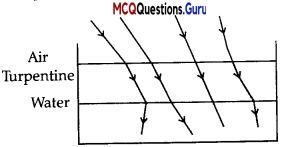
(A) 1
(B) 2
(C) 3
(D) 4
Answer:
(B) 2
Explanation:
μA < μr > μw
As inddence ray passes from air to turpentine to water it means, from rare to denser then denser to rarer so first it bends towards normal then away from normal so the path shown is correct for ray (2).
Optics MCQ Class 12 Chapter 9 Question 11.
A short pulse of white light is inddent from air to a glass slab at normal incidence. After travelling through the slab, the first colour to emerge is
(A) blue.
(B) green.
(C) violet.
(D) red.
Answer:
(D) red.
Explanation:
As we know that the velodty of wave is:
υ = vλ
When light ray goes from one medium to other medium, the frequency of light remains unchanged. So, υ ∝ λ or greater the wavelength, greater the speed. And, the light of red colour is of highest wavelength and therefore of highest speed. So, after travelling through the slab, the red colour emerges first.
![]()
Ray Optics And Optical Instruments MCQ Question 12.
Therc are certain materials developed laboratories which have a negative refractive index (Figure). A ray incident from air (medium 1) into such a medium (medium 2) shall follow a path given by:
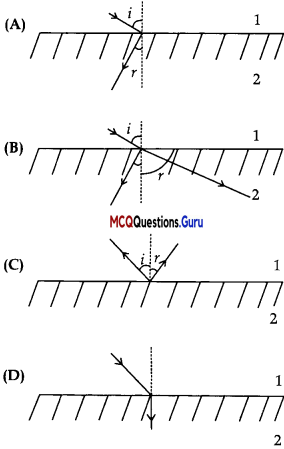
Explanation:
The negative refractive index materials are those in which inddent materials are those in which inddent ray from air (medium 1) to them refract or bends differently or opposite and symmetric to normal to that of positive refractive index medium.
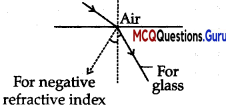
Optics MCQ With Answers Class 12 Question 13.
The radius of curvature of the curved surface of a plano-convex lens is 20 cm. If the refractive index of the material of the lens be 1.5, it will
(A) act as a convex lens only for the objects that lie on its curved side.
(B) act as a concave lens for the objects that lie on its curved side.
(C) act as a convex lens irrespective of the side on which the object lies.
(D) act as a concave lens irrespective of side on which the object lies.
Ans:
(C) act as a convex lens irrespective of the side on which the object lies.
Explanation: =
As we know the relations between f, μ, R1 and R2 is known as lens maker’s formula:
\(\frac {1}{f}\) = (μ – 1)\(\left(\frac{1}{R_{1}}-\frac{1}{R_{2}}\right)\)
R1 = ∞ , R2 = -R
f = \(\frac{R}{(\mu-1)}\)
Given that
R = 20 cm,
μ = 1.5
Put the values;
f = \(\frac {1}{μ – 1}\) = \(\frac {20}{15 – 1}\) 40cm
As f > 0, it means converging nature of the So, lens act as a conv lens irrespective of the side on which the object lies.
Class 12 Physics Ray Optics MCQ Question 14.
Radius of curvature of human eye is 0.78 cm. For an object at infinity, image is formed at 3cm behind the refracting surface. The refractive index of eye is –
(A) 1.35
(B) 3
(C) 6.2
(D) I
Answer:
(A) 1.35
Explanation:
\(\frac{\mu_{2}}{v}-\frac{\mu_{1}}{u}=\frac{\mu_{2}-\mu_{1}}{R}\)
Puffing υ = 3 cm
μ1 = 1
u = ∞
R = 0.78 cm
\(\frac{\mu_{2}}{3}-\frac{1}{\infty}=\frac{\mu_{2}-1}{0.78}\)
∴ μ2 = 1.35
![]()
Class 12 Physics Chapter 9 MCQ Question 15.
The relationship between angle of incidence i, prism of angle A and angle of minimum deviation for a triangular prism is
(A) A + δm = i
(B) A + δm = 2i
(C) A + δm/2 = i
(D) 2A + δm = i
Answer:
(B) A + δm = 2i
Explanation:
For refraction through prism,
i1 + i2 = 8 + A and r1 + r2 = A
For minimum deviation,
i1 = i2 = i and r1 = r2 = r
So, 2i = (A + δm)/2
A + δm = 2i
Ray Optics MCQ Chapter 9 Class 12 Question 16.
Which of the following graphs is the correct angle of incidence vs. angle of deviation graph?

Answer:
Option (A) is correct
Class 12 Ray Optics MCQ Chapter 9 Question 16.
Magnifying power of a microscope depends on
(A) colour of light.
(B) focal length of objective and colour of light.
(C) focal length of eyepiece and colour of light.
(D) focal length of eyepiece and objective.
Answer:
(D) focal length of eyepiece and objective.
Explanation:
Magnification = m ∝ 1/f0fe
So, magnifying power of a microscope depends on focal length of eyepiece and objective only.
Optics MCQ Chapter 9 Class 12 Question 17.
Magnifying power of a telescope is –
(A) 1/f0fe
(B) f0/fe
(C) fe/f0
(D) f0 fe
Answer:
(B) f0/fe
![]()
MCQ On Optics Class 12 Chapter 9 Question 18.
If m1 and m2 be the linear magnifications of the objective and eyepiece of a compound microscope, then the magnifying power of the compound microscope is
(A) m1 + m2
(B) m1 – m2
(C) m1 x m2
(D) (m1 + m2)/2
Answer:
(C) m1 x m2
Class 12 Physics Chapter 9 MCQs Question 19.
In a compound microscope, image produced by objective is …………… and the image produced by eyepiece is ………..
(A) Real, real
(B) Virtual, virtual
(C) Real, virtual
(D) Virtual, real
Answer:
(C) Real, virtual
Question 20.
Reflecting telescope utilises ……….
(A) Convex mirror
(B) Concave mirror
(C) Plane mirror
(D) Prism
Answer:
Option (B) is correct
Question 21.
The magnifying power of a telescope is M. If the focal length of the eyepiece is halved, the magnifying power will become
(A) M/2
(B) 4M
(C) M/4
(D) None of the above
Answer:
(D) None of the above
Explanation:
Magnifying power is inversely proportional to the focal length of eyepiece. So, if focal length of the eyepiece is halved, the magnification will be ZM.
![]()
Question 22.
You are given the following 3 lenses. Two construct an astronomical telescope which one will you used as eyepiece and which one as objective?

(A) L1, L2
(B) L2, L1
(C) L2, L3
(D) L3, LI
Answer:
(B) L2, L1
Explanation:
The objective should have large aperture and large focal length while eyepiece should have small aperture and small focal length.
Assertion And Reason Based MCQs (1 Mark each)
Directions: In the following questions, A statement of Assertion (A) is followed by a statement of Reason (R). Mark the correct choice as.
(A) Both A and R are true and R is the correct explanation of A
(B) Both A and R are true but R is NOT the correct explanation of A
(C) A is true but R is false
(D) A is false and R is True
Question 1.
Assertion (A): A convex mirror cannot form real images.
Reason (R): Convex mirror converges the parallel rays that are incident on it.
Answer:
(C) A is true but R is false
Explanation:
Convex mirror always form virtual image. So, the assertion is true. Parallel rays incident on convex mirror do not actually meet. They get reflected in such a manner that their extension meet at a point. So, the reason is false.
Question 2.
Assertion (A): The focal length of a concave mirror is/and an object is placed at a distance x from the focus. The magnification produced by the mirror is fix.
Reason (R): magnification = size of image / size of object
Answer:
(A) Both A and R are true and R is the correct explanation of A
Explanation:
u = f + x
Using mirror formula, l/υ + 1/u = 1/f
Or, l/υ – 1/(f + x) = -1/f
∴v = -f(f + x)/x
Magnification (m) = size of image / size of object = – υ/u
|m|= \(\frac{f(f+x)}{x} \times \frac{1}{f+x}\) = f/x
So, the assertion and reason both are true and the reason properly explains the assertion.
![]()
Question 3.
Assertion (A): The mirror formula l/υ + 1/u = l/f is valid for mirrors of small aperture.
Reason (R): Laws of reflection of light is valid for only plane surface and not for large spherical surface.
Answer:
(C) A is true but R is false
Explanation:
The mirror formula is derived under the consideration that the incident rays are paraxial which means that the rays lie very close to the principal axis. Hence the mirror aperture is considered to be small. So, the assertion is true. Laws of reflection is valid for any surface plane or spherical. Hence the reason is false.
Question 4.
Assertion (A): Air bubbles shine in water.
Reason (R): Air bubbles shine in water due to refraction of light.
Answer:
(A) Both A and R are true and R is the correct explanation of A
Explanation:
Air bubbles shine in water due to total internal reflection. Total internal reflection is a special case of refraction when light passes from denser medium (water) to rarer medium (air inside the bubble) and angle of incidence is more than the critical angle. So, the reason is also true. The reason also explains the assertion properly.
Question 5.
Assertion (A): A diamond of refractive index \(\sqrt{6}\) is immersed in a liquid of refractive index \(\sqrt{3}\) . If light travels from diamond to liquid, total internal reflection will take place when angle of incidence is 30°.
Reason (R): μ = 1/sin C, where p is the refractive index of diamond with respect to the liquid
Answer:
(D) A is false and R is True
Explanation:
Refractive index of diamond with respect to the liquid is \(\sqrt{6}\)/ \(\sqrt{3}\) = \(\sqrt{2}\) So, critical angle for the diamond-liquid pair of media is sin -1(1/ \(\sqrt{2}\) ) = 45°.
For total internal reflection, angle of incidence should be greater that critical angle. Since angle of incidence is 30°, total internal reflection cannot take place. So, the assertion is false. But the reason is true.
![]()
Question 6.
Assertion (A): A double convex air bubble is formed within a glass slab. The air bubble behaves like a converging lens.
Reason (R): Refractive index of glass is more that the refractive index of air.
Answer:
(D) A is false and R is True
Explanation:
Speed of light is slower in glass compared to that in air. Hence the refractive index of glass is more than that of air. So the reason is true.
When a double convex air bubble is formed within a glass slab, the refractive index of the medium of the bubble is less than the refractive index of the surrounding medium. Hence the lens will not behave like a converging lens. It will behave like a diverging lens. So, the assertion is false.
Question 7.
Assertion (A): The scattering of light while passing through a true solution is called Tyndall effect.
Reason (R): Intensity of scattered light is inversely proportional to the fourth power of wavelength.
Answer:
(D) A is false and R is True
Explanation:
When light is passed through a true solution does not occur. Scattering occurs when light is passed through a colloidal solution. So, the assertion is false. In Rayleigh scattering intensity of scattered light is inversely proportional to the fourth power of wavelength, blue light is scattered mush more strongly than red light. Hence the reason is true.
Question 8.
Assertion (A): A convex lens of focal length 30 cm can’t be used as a simple microscope in normal setting.
Reason (R): For normal setting, the angular magnification of simple microscope is M = \(\frac {D}{f}\)
Answer:
(B) Both A and R are true but R is NOT the correct explanation of A
Explanation:
For normal adjustment, a 30 cm lens final image cannot form image at the near point (25 cm from the eye). So the statement is true. For image at infinity, angular magnification of simple microscope is given by M = D/f.
So, the reason is also true. But reason does not explain the assertion.
![]()
Question 9.
Assertion (A): If the objective lens and the eyepiece lens of a microscope are interchanged, it works as a telescope.
Reason (R): Objective lens of telescope require large focal length and eyepiece lens require small focal length.
Answer:
(D) A is false and R is True
Explanation:
Magnification of microscope is inversely proportional to focal lengths of the objective lens and the eyepiece lens. Hence both the focal lengths are small. On the other hand, the magnification of the microscope is inversely proportional to the focal lengths of the eyepiece lens and directly proportional to the objective lens. So, the focal length of the objective lens is large and the focal length of the eyepiece lens is small. Hence, if the objective lens and the eyepiece lens of a microscope are interchanged that will not meet the criterion of the telescope. So, the reason is true. But the assertion is false.
Question 10.
Assertion (A): Convex lens behaves like a simple microscope.
Reason (R): For larger magnifying power, the focal length of the convex lens should be small.
Answer:
(A) Both A and R are true and R is the correct explanation of A
Explanation:
Convex lens behaves like a simple microscope. The assertion is true. The magnifying power of a convex lens is expressed as:
For least distance of distinct vision, m = 1 + D/f
For relaxed eye, m = D/f Since / is in the denominator, for larger magnifying power, focal length should be small. So, the reason is also correct and it is the assertion.
Case-Based MCQs
Attempt any 4 sub-parts out of 5. Each sub-part carries 1 mark.
I. Read the following text and answer the following questions on the basis of the same:
Sparking Brilliance of Diamond:
The total internal reflection of the light is used in polishing diamonds to create a sparking brilliance. By polishing the diamond with specific cuts, it is adjusted the most of the light rays approaching the surface are incident with an angle of incidence more than critical angle. Hence, they suffer multiple reflections and ultimately come out of diamond from the top. This gives the diamond a sparking brilliance.
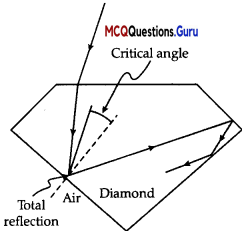
Question 1.
Light cannot easily escape a diamond without multiple internal reflections. This is because:
(A) its critical angle with reference to air is too large.
(B) its critical angle with reference to air is too small.
(C) the diamond is transparent.
(D) rays always enter at angle greater than critical angle.
Answer:
(B) its critical angle with reference to air is too small.
Explanation:
Light cannot easily escape a diamond, because its critical angle with air is too small. Most of the reflections are total and it is cut so that light can exit only in particular direction thus light is concentrated inside and making the diamond sparkle.
![]()
Question 2.
The critical angle for a diamond is 24.4°. Then its refractive index is:
(A) 2.42
(B) 0.413
(C) 1
(D) 1.413
Answer:
(A) 2.42
Explanation:
Refractive index = 1/ sin C
C = critical angle = 24.4
∴μ = 1/sin 24.4 = 1/0.4131 = 2.42
Question 3.
The basic reason for the extraordinary sparkle of suitably cut diamond is that:
(A) it has low refractive index.
(B) it has high transparency.
(C) it has high refractive index.
(D) it is very hard.
Answer:
(C) it has high refractive index.
Explanation:
The brilliance of diamond is due to its too small critical angle with air. As the critical angle become smaller, value of sine of critical angle also become small and hence refractive index increases (since p= 1/sinC). So, the basic reason for the extraordinary sparkle of suitably cut diamond is its high refractive index.
Question 4.
A diamond is immersed in a liquid with a refractive index greater than water. Then the critical angle for total internal reflection will:
(A) depend on the nature of the liquid.
(B) decrease.
(C) remains the same.
(D) increase.
Answer:
(D) increase.
Explanation:
A diamond is immersed in a liquid with a refractive index greater than water. Then the critical angle for total interned reflection will increase. This is because, as the refractive index of outer medium increases, the refracted ray bends less away from normal. So, angle of incidence should increase more to achieve 90° angle of refraction.
![]()
Question 5.
The following diagram shows same diamond cut in two different shapes.
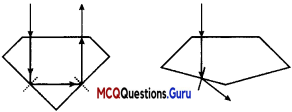
The brilliance of diamond in the second diamond will be:
(A) less than the first.
(B) greater than first.
(C) same as first.
(D) will depend on the intensity of light.
Answer:
(A) less than the first.
Explanation:
The brilliance of diamond in the second diamond will be less than the first since in the second case, no total internal reflection has taken place.
II. Read the following text and answer the following questions on the basis of the same:
Photometry:
The measurement of light as perceived by human eye is called photometry. Photometry is measurement of a physiological phenomenon, being the stimulus of light as received by the human eye, transmitted by the optic nerves and analysed by the brain. The main physical quantities in photometry are (i) the luminous intensity of the source, (ii) the luminous flux or flow of light from the source and (iii) illuminance of the surface. The SI unit of luminous intensity (I) is candela (cd).
The candela is the luminous intensity, in a given direction, of a source that emits monochromatic radiation of frequency 540 x 1012 Hz and that has a radiant intensity in that direction of 1/683 watt per steradian. If a light source emits one candela of luminous intensity into a solid angle of one steradian, the total luminous flux emitted into that solid angle is one lumen (lm). A standard 100 watt incandescent light bulb emits approximately 1700 lumens.
Question 1.
What is photometry?
(A) Measurement of light as perceived by human eye
(B) Measurement of number of photons emerging from a light source
(C) Measurement of electrons emitted by photosensitive surface
(D) Measurement of photosensitivity
Answer:
(A) Measurement of light as perceived by human eye
Explanation:
The measurement of light as perceived by human eye is called photometry.
Question 2.
Light received by human eye is analysed by:
(A) retina
(B) brain
(C) optic nerve
(D) nervous system
Answer:
(B) brain
Explanation:
Light received by the human eye, transmitted by the optic nerves and analysed by the brain.
![]()
Question 3.
The SI unit of luminous intensity is:
(A) Dioptre
(B) Steradian
(C) Candela
(D) Lumen
Answer:
(C) Candela
Explanation:
The SI unit of luminous intensity is candela (cd).
Question 4.
Unit of luminous flux is:
(A) Candela
(B) Steradian
(C) Nit
(D) Lumen
Answer:
(D) Lumen
Explanation:
The total luminous flux emitted into a solid angle is one lumen (lm).
Question 5.
A standard 100 watt incandescent light bulb emits approximately:
(A) 1700 Lumen
(B) 700 Lumen
(C) 1200 Lumen
(D) 1000 Lumen
Answer:
(A) 1700 Lumen
Explanation:
A standard 100 watt incandescent light bulb emits approximately 1700 lumens.
III. Read the following text and answer the following questions on the basis of the same:
Optical Fibre:
Optical fibre works on the principle of total internal reflection. Light rays can be used to transmit a huge amount of data, but there is a problem here – the light rays travel in straight lines. So unless we have a long straight wire without any bends at all, harnessing this advantage will be very tedious. Instead, the optical cables are designed such that they bend all the light rays’ inwards (using TIR). Light rays travel continuously, bouncing off the optical fibre walls and transmitting end to end data. It is usually made of plastic or glass.
![]()
Modes of transmission:
Single-mode fibre is used for long-distance transmission, while multi¬mode fiber is used for shorter distances. The outer cladding of these fibres needs better protection than metal wires. Although light signals do degrade over progressing distances due to absorption and scattering. Then, optical Regenerator system is necessary to boost the signal.
Types of Optical Fibres:
The types of optical fibers depend on the refractive index, materials used, and mode of propagation of light. The classification based on the refractive index is as follows:
Step Index Fibres:
It consists of a core surrounded by the cladding, which has a single uniform index of refraction. Graded Index Fibres: The refractive index of the optical fibre decreases as the radial distance from the fibre axis increases.
Question 1.
Optical fibre works on the principle of:
(A) scattering of light.
(B) diffraction of light.
(C) total internal reflection of light.
(D) dispersion of light.
Answer:
(C) total internal reflection of light.
Explanation:
The optical fibre works on the principle of total internal reflection.
Question 2.
For long-distance transmission:
(A) single mode fibre is used.
(B) multi-mode fibre is used.
(C) both single mode and multi-mode are used.
(D) any one of single mode or multi-mode may be used.
Answer:
(A) single mode fibre is used.
Explanation:
Single-mode fibre is used for long-distance transmission, while multi-mode fibre is used for shorter distances.
![]()
Question 3.
Optical fibre is made of:
(A) copper
(B) semiconductor
(C) plastic or glass
(D) superconductors
Answer:
(C) plastic or glass
Explanation:
Optical fibre is usually made of plastic or glass, so that light rays can travel continuously, bouncing off the optical fibre walls and can be transmitting end to end data.
Question 4.
In graded index optical fibre:
(A) the refractive index of the optical fibre increases as the radial distance from the fibre axis increases.
(B) the refractive index of the optical fibre decreases as the radial distance from the fibre axis increases.
(C) the refractive index of the optical fibre remains same throughout.
(D) inner side of cladding is mirrored to ensure reflection.
Answer:
(B) the refractive index of the optical fibre decreases as the radial distance from the fibre axis increases.
Explanation:
In graded index fibres, the refractive index of the optical fibre decreases as the radial distance from the fibre axis increases.
Question 5.
Light signal through optical fibre may degrade due to:
(A) refraction.
(B) refraction and reflection.
(C) diffraction and scattering.
(D) scattering and absorption.
Answer:
(D) scattering and absorption.
![]()
Explanation:
Light signals do degrade over progressing distances due to absorption and scattering.
IV. Read the following text and answer the following questions on the basis of the same:
Negative Refractive Index:
One of the most fundamental phenomena in optics is refraction. When a beam of light crosses the interface between two different materials, its path is altered depending on the difference in the refractive indices of the materials. The greater the difference, the greater the refraction of the beam. For all known naturally occurring materials the refractive index assumes only positive values. But does this have to be the case? In 1967, Soviet physicist Victor Veselago hypothesized that a material with a negative refractive index could exist without violating any of the laws of physics.
Veselago predicted that this remarkable material would exhibit a wide variety of new optical phenomena. However, until recently no one had found such a material and Veselago’s ideas had remained untested. Recently, meta-material samples are being tested for negative refractive index. But the experiments show significant losses and this could be an intrinsic property of negative- index materials. Snell’s law is satisfied for the materials having a negative refractive index, but the direction of the refracted light ray is ‘mirror-imaged’ about the normal to the surface.
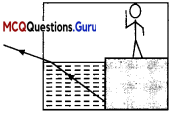
There will be an interesting difference in image formation if a vessel is filled with “negative water” having refractive index – 1.33 instead of regular water having refractive index 1.33. Say, there is a fish in a vessel filled with negative water. The position of the fish is such that the observer cannot see it due to normal refraction since the refracted ray does not reach to his eye.
But due to negative refraction, he will be able to see it since the refracted ray now reaches his eye.
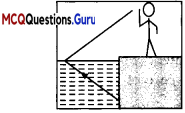
Question 1.
Who hypothesized that a material may have negative refractive index ?
(A) Joseph Von Fraunhofer
(B) Augustin-Jean Fresnel
(C) Thomas Moore
(D) Victor Veselago
Answer:
(D) Victor Veselago
Explanation:
In 1967, Soviet physicist Victor Veselago hypothesized that a material with a negative refractive index could exist without violating any of the laws of physics.
Question 2.
Is Snell’s law applicable for negative refraction ?
(A) Yes
(B) No
(C) Unpredictable
(D) Yes, only for normal incidence
Answer:
(A) Yes
Explanation:
Snell’s law is satisfied for the materials having a negative refractive index, but the direction of the refracted light ray is ‘mirror-imaged’ about the normal to the surface.
Question 3.
A ray in incident on normal glass and “negative glass” at an angle 60°. If the magnitude of angle of refraction in normal glass is 45° then, what will be the magnitude of angle of refraction in the “negative glass”?
(A) Less than 45°
(B) More than 45°
(C) 45°
(D) Unpredictable
Answer:
(C) 45°
Explanation:
The magnitude of angle of refraction in normal “negative glass’ will also be 45°, but the direction of the refracted light ray is ‘mirror-imaged’ about the normal to the surface.
![]()
Question 4.
When the angle of incidence will be equal to angle of refraction for material having negative refraction index?
(A) When angle of incidence = 90°
(B) When angle of incidence = 0°
(C) It will vary from material to material
(D) It is never possible
Answer:
(B) When angle of incidence = 0°
Explanation:
Like normal refraction, for material having negative refraction index also when the angle of incidence is equal to 0°, then angle of refraction will be equal to angle of incidence i.e. 0°.
Question 5.
Which of the following is the intrinsic property of negative-index materials?
(A) Significant gain of light energy due to refraction
(B) No loss of light energy due to refraction
(C) Significant loss of light energy due to refraction
(D) Loss of energy due to refraction in intermittent
Answer:
(C) Significant loss of light energy due to refraction
Explanation:
Recently, meta-material samples are being tested for negative refractive index. The experiments show significant losses and this is an intrinsic property of negative index materials.
V. Read the following text and answer the following questions on the basis of the same:
First Surface Mirror:
Normally we use back surface mirrors. These are considered low precision mirrors because they actually have two reflecting surfaces. The first reflecting surface is the initial surface on the pane of glass where a small percentage of light is reflected off the surface. The second reflecting surface is the aluminium coating where a high percentage of light is reflected off the surface.
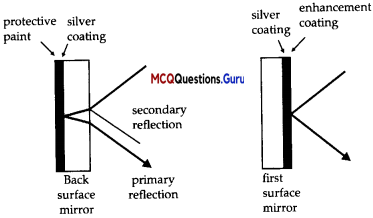
This dual reflection effect of a low precision mirror causes a loss of contrast and image distortion that is undesirable in high precision applications like rear projection systems, scanners and reflecting telescopes. In these cases good image quality is highly preferred, and this is where a front surface mirror is desired for clarity and single image reflection. First surface mirrors are quite common in professional optics.
However, compared with back surface mirrors, they have the important disadvantage of being substantially more sensitive. The front surface may be touched, and a metal coating on the front surface is substantially more sensitive than a bare glass surface. For example, fingerprints can easily cause oxidation of the metal.. Also, moisture or aggressive gases may cause oxidation of the mirror coating.
Question 1.
Precision of back surface mirrors is:
(A) high.
(B) low.
(C) depends on intensity of light.
(D) similar to first surface mirror.
Answer:
(B) low.
Explanation:
Normally, we use back surface mirrors. These are considered low precision mirrors because they actually have two reflecting surfaces.
Question 2.
Light incident on back surface mirror suffers:
(A) two reflections.
(B) one reflection.
(C) two reflections and two refractions.
(D) one refraction and one reflection.
Answer:
(C) two reflections and two refractions.
Explanation:
This dual reflection and refraction effect of a low precision, mirror causes a loss of contrast and image distortion.
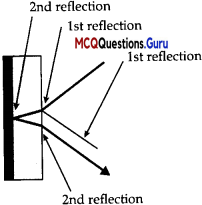
![]()
Question 3.
In professional optics:
(A) first surface mirrors are used.
(B) back surface mirrors are used.
(C) both type of mirrors are used.
(D) mirrors are not used.
Answer:
(A) first surface mirrors are used.
Explanation:
First surface mirrors are quite common in professional optics.
Question 4.
The image formed of the front coated mirror:
(A) suffers astigmatism
(B) is brilliant
(C) has low contrast
(D) is a dual image
Answer:
(C) has low contrast
Explanation:
The front surface mirror produces bright, distinct and distortion-less image. No ghost image is formed.
Question 5.
The front surface coating:
(A) is susceptible to moisture.
(B) is not so sensitive.
(C) is worse than back surface coating.
(D) cannot prevent dual reflection.
Answer:
(A) is susceptible to moisture.
Explanation:
The front surface mirror is substantially more sensitive than a bare glass surface. For example, fingerprints can easily cause oxidation of the metaL Also, moisture or aggressive gases may cause oxidation of die mirror coating.